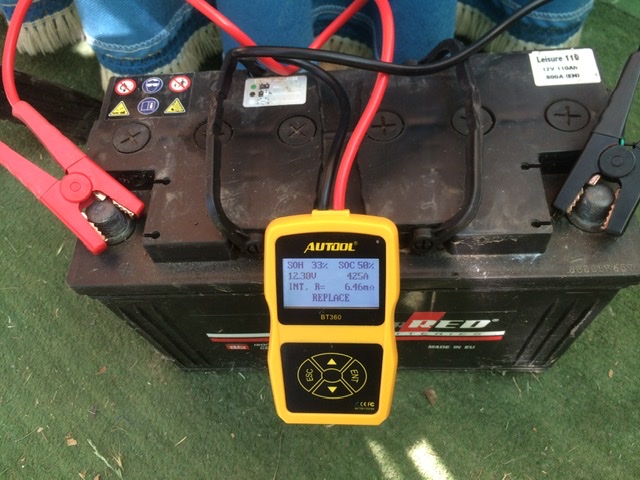This applies only to lead batteries, like truck, car or motorcycle batteries, which are heavy as their volume would be filled with sand. It is nothing scientific or exact in this article, but rather the way of explaining a common sense of preserving your lead batteries, would be for your solar or car.
Let’s take as example, medium size, new, 12V car battery.
When we say 12V battery, it does not mean it has exactly 12V, but more or less. This explained below.
Battery is very expensive component. It is a component which can be destroyed easily and quickly.
Bicycle flat tire story:
To fully charge a low-charge battery, is like fully inflate a bicycle’s flat tire:
— first (and most quick and easy) is pumping until the flat tire get’s in to it proper shape (inflated, visually right shaped, but still soft),
— the rest, is to pressure pump-up until tire becomes hard.
Tire size does not change if you put more air in to it, but will explode if you put to much.
For the 12V battery this means:
— flat tire = lesser than 11V;
— soft tire = about 12V;
— normal/hard tire = 12.2V — 12.6V;
— a very hard tire = 12.8V — 13.5V;
— max pressure while pumping = 14.5V;
While battery is on charge, the pushing energy in to battery makes 14.5V, in order to have enough pressure to pump it with energy.
When battery is fully charged (hard tire), it might maintain some 13.7V for a while, but eventually will normalize down to 12.6V;
When battery is discharged (flat tire), this means battery power has dropped to 11V (or below!);
Keeping battery’s charge in a range of 11V to 12.6V (max 14.5V while charging) means, maintaining battery’s good health; such battery will serve you very very long.
Breathing example (for better explanation — feel yourself as the battery feels)
Step One:
- Breath normally;
- Memorize the speed of your normal breathing;
- Stop at the exhaled point and memorize it;
- Stop at the inhale point and memorize it;
From above example, top-inhale point is like the charge of 12.8V and bottom exhale point is like 12.4V; Normal breathing, feels unforced and normal until it falls into range of 12.4 — 12.8V;
Step Two:
- Inhale up to normal top point and stop (keep inhaled);
- Inhale with force and take the most air you can;
- Exhale down to normal point and stop (keep exhaled);
- Exhale with force, push all the air out of your lungs;
Example above explains the max-min ranges of acceptable charge — the full possible intake of air in your lungs is like a charge of 14.5V; and with fully exhaled, no air in lungs should give you an idea of battery stage when charge drops down to 11V;
Obviously, if you inhale most you can (charge reaching 14.5V) and I will pump even more air in to you lungs — lungs will get damaged. Same happens to battery, if more than 14.5V is kept pushing in to battery. Every battery charger/controller cuts the charging power if the maximum charge (14.5V) is reached; .
Vice versa, if you exhale all the air (charge dropped to 11V) from your lungs, and I will apply a lot of pressure upon your lungs, I still will get some air out of it; you will fade but you won’t die yet. Your breathing will not get back to normal anymore; The more often this is repeated, the worse it gets (further explained in Battery Capacity); This effect called battery drainage and should be most avoided. DO NOT OVER-DRAIN YOUR BATTERY!
Step Three:
- Keep breathing normally, to memorize the range of breath;
- In a same range of breath, start breathing rapidly. Faster!
- Fast breathing should take at least 6 times faster than normal;
When we run up the hill, we start to breath faster and getting tired quicker. We might use same number of breaths to cover same distance (walking up the hill) but this is not the same effect as a walking, which will consume lesser energy.
Example below explains applied load for the battery:
Let’s connect a load to the battery — a single lamp to keep it glowing for 10 hours; Now, let’s connect 10 same lamps, but keep it glowing for only 1 hour;
Calculation is the same: 1 lamp glowing for 10 hours OR 10 lamps glowing for 1 hour will consume same amount of energy; Despite the same amount of energy used, serving bigger loads makes battery to get tired faster. In fact, slower discharge keeps battery serving LONGER.
Another example is electric bicycle: Let’s take it for a 10 times run up and down the same heal. Which is, 5 times going down-the-heal — no power used AND 5 times going up-the-heal — more power used. Let’s presume, this covers 20km and consumes all the battery power. Now, if you run bicycle on a flat road until battery is discharged, you should cover 30-40km.
Battery Capacity

See image above. Take a close look at this foam sponges. They are all cut in to same square shape, but first one is THICK and the last one is WEAK. Similarly to story with bicycle’s tire – same shape, but not the same amount of air inside..
New (or healthy) battery:
Imagine, battery stores energy in a sponge. The thicker sponge is, the more energy can be stored in it, the longer can it serve. To pump the energy in to such sponge (to charge the battery up to 14.5V) takes long time.
Weak battery:
When battery often is over-drained (explained above), the storage capacity gets weaker. Like a weak sponge, it has not much of a matter where energy could be held/stored. To fill-up (to charge fully) such weak sponge with energy, does NOT take long. Battery is charged up to 14.5V in very short time.
How to measure battery capacity?
Or how thick sponge is?
Voltmeter will not show you anything but Volts only. You can take measurements of completely new battery which has been used until it reached 11V and in a few hours it will (normalize and) show you some 11.9V. This does mean battery is weak or bad. It simply should be recharged again, as soon as possible (read about battery storage below).
You can measure Volts in charged but weak battery and it will show you 12.4V, but this will not suggest you how thick the sponge is.
The only way to get the true picture of how thick sponge is, is a special gadget, called Battery Capacity Tester. Usually tester gives results called SOH, meaning Stage Of Health shown in percentage. So if the tester gives you SOH 50%, this means your sponge is twice weaker than a new one. Such battery takes twice faster to charge fully and serves twice shorter, comparing to a new one.

This is 110Ah battery. SOH 33% suggests, this battery has ⅓ of 110Ah
which makes approx definite 30Ah of battery actual capacity.
SOC = State Of Charge.
MANUALLY MEASURE battery capacity is possible, but not straight forward. First, charge it fully (up to it takes 14.5V), then, connect a bulb, which consumes 12W of power and keep it until battery will reach 11V and note how long it did serve.
For human to understand, battery capacity is stated in Amper-hours (or Ah). Every battery will have a label saying how many hours could be stored in a battery to serve consumption of 1 Amper. Let me skip very fine details and simply tell, that in our case 1 Amper is equal to 12 Watt (for example, bulb of 50W will consume: 50W/12V = 4Amp (approx));
If battery label says 50Ah, this means you should be able to use 1Amp (or a 12W bulb) for roughly 50 hours continuously. If your bulb has served 5 hours only, from full-charge down to 10.8V, this means capacity of battery is roughly 5Ah which is ten times weaker, comparing to the new battery. Battery tester will show SOH of 10-15% only.
Battery’s long term storage:
Unused battery does not hold the charge for ever!
New, fully charged battery can rest up to 8 months, then it should be fully charged again. Best practice, is to charge it fully every 6 months. Some chargers will have a “winter” charge mode, or very slow charging, which is rather to keep battery‘s non-floating Voltage. Keeping unused battery constantly connected to the charger will not do any harm, but opposite — the battery’s sponge gets tuned-up in to best shape of thickness.
So if you left in your garage good and fully charged battery for two years untouched — probably it is half-dead already.
But if you keen to keep battery in good shape, remember just a few things:
- keep an eye on battery’s Voltage and never allow it reach the 11V or below. When this happens, recharge ASSAP;
- do not overcharge — always use charge/discharge controllers, which cuts the incoming power if battery reached 14.5V and cuts consumption if battery reached 11V;
- charge long-term-stored batteries at least once every six months OR simply leave them constantly connected to the charger;